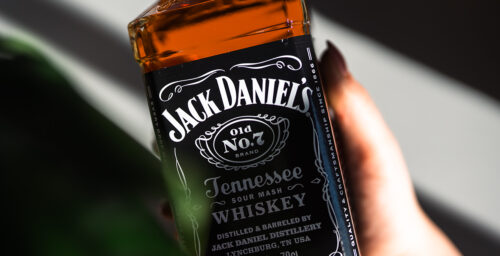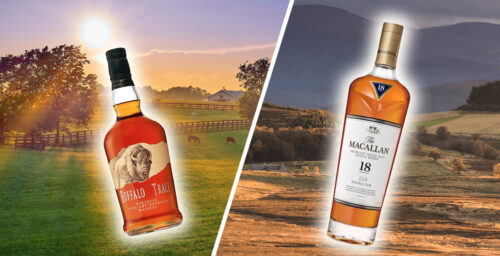Because of the booming character of the French whisky industry I am curious what is left of one of their high altars of alcoholic beverages: cognac. To find out I travel with some friends to the cognac house of Delamain in the small town of Jarnac.
Rebecca Montgomery
The squeaky staircase up to the office breathes an atmosphere of grandeur just like how a 200 year old cognac house should be in my opinion. We are welcomed by Rebecca Montgomery. Being Irish by birth and French by heart she seems to me the perfect reflection of the Delamain history. After all, it was Irishman James Delamain who established the firm in 1759. With Société Jacques Bollinger being majority shareholder now the preservation of the unique history and heritage of Delamain is guaranteed.
Historic ground
It’s like embarking on a time machine which takes me back more than 2 centuries ago. ‘Nothing has changed’, Rebecca says when we enter the tasting and blending room. All around I see remnants of a long history: a letter of Sir Winston Churchill next to a framed international spirits prize from 1906. ‘Cognac was stored here even before the French Revolution’, she adds. ‘Our main cellar dates back to the sixteenth century’. ’This really is historic ground’, I hear myself whisper.
We begin where others finish
Delamain is located in Jarnac in what is called the Grande Champagne region. The other five regions are: Petite Champagne, Fin Bois, Borderies, Bon Bois and Bois Ordinaires. ‘Delamain begins where others finish’ says Rebecca. We do not distill, we select, age and blend cognacs exclusively from the Grande Champagne terroir. We reduce our strengths in the vats down to 40% abv with ‘faibles’, a combination of old brandy and distilled water at 15 percent abv’.
Olivier Guillateau
As we walk from the office to the first storage area on the first floor Rebecca and cellar master and master blender Olivier Guillateau are more than happy to guide us around. The area is filled with barrels of various years. We stop at a barrel with the year 1959 written on top. Olivier drops a few centiliters in our glasses with his wine thief. I bury my nose deep into the tulip glass. How does one recognize flavours one has never encountered before in his entire life ? And where was I in 1959 ? For how much longer will this barrel of cognac be sleeping here ? All questions I cannot answer. Olivier points out that this cognac can very well be used to balance a final cognac. ‘It’s the art of waiting and blending that makes our Delamain cognacs so different from many other cognacs’, Rebecca explains.

Cognac archives
I realize that this art of blending has solely been done by nose for so many years. It’s the silence in this place that creates this atmosphere of sanctity. No brewing or fermentation sounds or the hissing of copper stills at work, no meters ticking frantically, nothing of the kind. Every cognac barrel here is fast asleep, waiting to be blended. Well, at least most of them. Behind me, racked on the outside wall, a lot of demijohns are kept. Some of them date back to 1840. Rebecca again stresses that ‘This too is cognac we occasionally use to boost a particular blend. In a sense these demijohns are our archives because they trace the history of Delamain’. Sometimes Delamain gets requests to sell an entire demijohn, to a London club for example because of the theatre of serving from a demijohn. ‘But they are hard to obtain. We might sell them the cognac, but ideally we would like the vessel back’.
Cask strength
Delamain is a small cognac house. ‘We bottle in a year what the big houses bottle in 3 days’, Rebecca continuous. ‘Another difference is that all our cognacs are made with 100% Grande Champagne eau de vie’. And, yes, this results in an haute couture cognac, one with an almost perfumed finesse going up to 60 years. ‘Eaux-de-vie originating from other terroirs typically evolve more quickly in the cask’, Rebecca says. From here we go outside across the yard to the cellar where the cask strength barrels are stored. In there we are introduced to the many terroir differences that the Grande Champagne area has. We smell cognac from different vineyards or villages in this cognac producing region. Although the geographical distances are sometimes small, the terroir tells its own story.
A taste of the extraordinary
We go back to the small office and start off with Delamain’s flagship cognac, the Pale & Dry XO. ’We sell more of this cognac than any other cognac. Most of the time we drink it neat, but it’s also delicious if drunk frozen or with an ice cube. Pair it with Roquefort cheese, Cheddar, salty cheeses and smoked fish. It really accompanies a good meal’, Rebecca adds. The next treat in line is the Vesper. A cognac that is an outsider in its range. It is another ten years older than the Pale & Dry, more robust, with a touch of spice, a silky texture and unbelievably smooth. A classic cigar cognac. ‘This was created in the 1950s. There’s no comparison with a similarly aged whisky, neither pricewise nor quality wise. A lot of younger people nowadays are exploring cognac for that reason. Because they realize how much you can get for your money’, our host says.
We move on to the Extra, older still, a blend created in 2006. It gets quieter in the small tasting room when Rebecca picks up the Très Vénérable, and as its name suggests, the oldest in Delamain’s principal range. Olivier adds: ‘this one spent more time maturing. You get the citrus notes, fig, prunes, walnut…..all flavours from the cask. It keeps evolving’. The latest cognac Rebecca has in store for us is a vintage of 1988, unblended of course, from one vineyard. Again, heaven in disguise, but again not surprising when you take into account the high quality and constant level Delamain Cognac continuously aims at.
After all: Delamain begins, where others finish.








